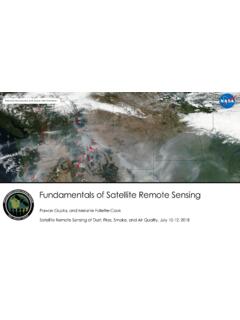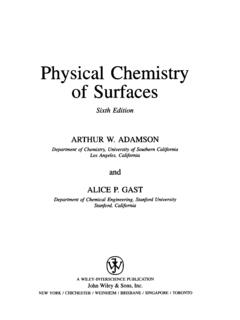Transcription of Student-Centered Teaching Methods - Teaching Handbook
1 Student-Centered Teaching Methods (adapted by C. Sealfon from Table 2 of the PCAST report) Types of active learning with feedbackDescriptionExamples of studies that demonstrate enhanced learningSmall group discussion and peer instruction (also called "Think-Pair-Share" or "ConcepTests")(example) students think about the answer to a question posed by the instructor, and then discuss the question among each other. The instructor selects students to explain the consensus to the et al. (2005); Armbruster et al. (2009); Armstrong et al. (2007); Beichner et al. (1999); Born et al. (2002); Crouch and Mazur (2001); Fagen (2002); Lasry et al. (2008); Lewis and Lewis (2005); McDaniel (2007a, 2007b); Rivard and Straw (2000); Tessier (2004 and 2007); Tien et al. (2002)Effective use of clickers(examples/videos)Hand-held electronic devices can allow students to anonymously vote on answers to multiple-choice questions in real time.
2 Clickers are usually most effective when used with peer et al. (2009, 2011) One-minute papers(example)Given an open-ended question, students spend one minute writing their answers on index cards, which are collected by the instructor. Often given at the end of class, the questions ask students what was the most important concept they learned or what remains et al. (1998); Chizmar and Ostrosky (1998); Rivard and Straw (2000)Interactive lecture demonstrations (ILDs)(example) students make predictions about the outcome of a classroom demonstration. They then observe the experiment or demonstration, describe the results, and discuss and reflect on the observed et al. (2004); Sharma et al. (2010)Case studies(examples) students draw inferences and make decisions given a detailed description of a scenario (often based on a true story).Preszler (2009) Concept mapping(example) students create a visual representation (similar to a flow chart) that identifies and shows the interconnections among various ideas related to a specific topic or et al.
3 (2004); Prezler (2004); Yarden et al. (2004) Tutorial worksheets(example) students work through guided-discovery worksheets that lead them through a chain of logic to solve a problem or overcome a conceptual difficulty. students complete the exercises in small groups, while the instructor circulates among the groups to ask targeted questions or to facilitate discussion (as needed or at specific check points in the worksheet).Ambrose (2004); Finkelstein and Pollock (2005); McDermott et al. (1994); Prather et al. (2004) Council on Science and Technology, 2012 1 Problem-based learning(example context-rich problems) students work in groups to solve complex, multifaceted, and realistic problems, researching and learning necessary background material as and Kuhn (2004); Heller et al. (1992); Preszler et al. (2007)Just-in-time Teaching (examples) students submit answers to questions about pre-class reading online, due a few hours before class.
4 Answers are graded based on completion and effort, not correctness, and inform the instructor s lesson and Novak (2004)Analytical challenge before lecture (also called "invention activities")(example--scroll to ) students make predictions or attempt to answer questions before learning about the answers in class. The effort is more important that the accuracy of the attempted and Bransford (1998)Computer simulations and games(example game)(example simulations) students use interactive computer simulations or online games to visualize phenomena, test predictions, receive prompt, targeted feedback to refine their intuitions, and conduct and analyze virtual et al. (2009); McDaniel et al. (2007); Traver et al. (2001)Group testsA test is given twice to the same students . The first time, students answer the questions individually (as in a normal test) and submit their answer sheets. Then students are allowed to work in groups and re-take the same test.
5 The two scores (individual and group) are et al. (2003); Klappa (2009)Problem sets in groupsStudents work on problem sets in teams, and submit one set of solutions per team. Cortright et al. (2005)Random callingThe instructor informs the class that students will be selected at random to respond to a question (perhaps using a shuffled deck of index cards with students names). Then, the instructor poses the question to the class, and remains silent for tens of seconds to allow everyone to think through an answer. After a sufficient pause (or perhaps after peer instruction), the instructor selects a student at random to share thoughts about the answer. Then, the instructor calls on another student at random to comment on the first student s (1997)Writing with peer reviewStudents evaluate each other's writing using a rubric or criteria provided by the (2002) Council on Science and Technology, 2012 2 : Almer, E.
6 , K. Jones, and C. Moeckel. (1998). The impact of one-minute papers on learning in an intro ductory accounting course. Issues in Accounting Education 13(3): , B. S. (2004). "Investigating student understanding in intermediate mechanics: Identifying the need for a tutorial approach to instruction." American Journal of Physics, 72(4):453 , W. L., Mitchell, S. M., and Osgood. (2005). Comparison of student performance in cooperative learning and traditional lecture-based biochemistry classes. Biochemistry and molecular biology education: A bimonthly publication of the International Union of Biochemistry and Molecular Biology 33(6): 387-93. Armbruster, P., M. Patel, E. Johnson, and M. Weiss. (2009). Active learning and Student-Centered pedagogy improve student attitudes and performance in introductory biology. Education 8: 203-213. Armstrong, N., S. Chang, and M.
7 Brickman. (2007). Cooperative learning in industrial-sized biology classes. Education 6: 163-171. Beichner, R. J., Saul, Abbott, Morse, Deardorff, R. J. Allain, et al. (2007). The Student-Centered activities for large enrollment undergraduate programs (SCALE-UP) project. In E. F. Redish & P. J. Cooney (Eds.), Research-Based Reform of University Physics. College Park, MD: American Association of Physics Teachers. Born, W. K., W. Revelle, and Pinto. (2002). Improving biology performance with workshop groups. Science Education 11(4): 347. Buck, H. J. (1997). "Maximizing student learning with the use of random oral questioning in the college classroom." Florida Journal of Educational Research 37(1).Buckley, M., H. Kershner, K. Schindler, C. Alphonce, and J. Braswell. (2004). Benefits of using socially-relevant projects in computer science and engineering education. SIGCSE 04: Proceedings of the 35th SIGCSE Technical Symposium on Computer Science Education 36(1): 482 486.
8 Capon, N. and D. Kuhn. (2004). What s so good about problem-based learning? Cognition and Instruction 22(1): 61-79. Chizmar, J. F. and Ostrosky. (1998). The one-minute paper: Some empirical findings. The Journal of Economic Education 29(1):3. Cortright, R. N., Collins, Rodenbaugh, and DiCarlo. (2003). Student retention of course content Is improved by collaborative-group testing. AJP: Advances in Physiology Education 27(3): 102-108. Cortright, R. N., Collins, and DiCarlo. (2005). Peer instruction enhanced meaningful learning: ability to solve novel problems. Advances in Physiology Education 29(2): 107-11. Crouch, C. H., A. P. Fagen, J. P. Callan, and E. Mazur. (2004). "Classroom demonstrations: Learning tools or entertainment?" American Journal of Physics (72)6: , C. H., and E. Mazur. (2001). Peer Instruction: Ten years of experience and results. American Journal of Physics 69(9): 970.
9 Fagen, A. P. (2002). Peer instruction: results from a range of classrooms. The Physics Teacher 40(4): 206. Finkelstein, N. D. and S. J. Pollock. (2005). "Replicating and understanding successful innovations: Implementing tutorials in introductory physics." physical Review Special Topics: Physics Education Research 1(1).Fonseca, A. P., Extremina, and Fonseca. (2004). Concept mapping: A strategy for meaningful learning in medical microbiology. First International Conference on Concept Mapping. Pamplona, on Science and Technology, 2012 3 , S., E. O. Connor, Parks, M. Cunningham, D. Hurley,D. Haak, C. Dirks, and Wenderoth. (2007). Prescribed active learning increases performance in introductory biology. Education 6 , M. A., Peck, S. Colton, J. Morris, Neto, and J. Kallio. (2009). A combination of hand-held models and computer imaging programs helps students answer oral questions about mole cular structure and function: A controlled investigation of student learning.
10 CBE Life Sciences Education 8(1): , P., R. Keith, and S. Anderson. (1992). " Teaching Problem Solving Through Cooperative Grouping. Part 1: Group Versus Individual Problem Solving." American Journal of Physics 60(7): , P. (2009). Promoting active learning through pub quizzes a case study at the University of Kent. Evaluation 14 (December), Article , N., E. Mazur, and J. Watkins. (2008). Peer instruction: From Harvard to the two-year college. American Journal of Physics 76(11): , S. E. and Lewis. (2005). Departing from lectures: An evaluation of a peer-led guided inquiry alternative. Journal of Chemical Education 82(1): , K. A., and G. M. Novak. (2004). "Just-in-Time Teaching in Biology: Creating an Active Learner Classroom Using the Internet." Cell Biology Education 3 (1): , C. N., Lister, Hanna, and H. Roy. (2007). Increased learning observed in redesigned introductory biology course that employed web-enhanced, interactive pedagogy.



